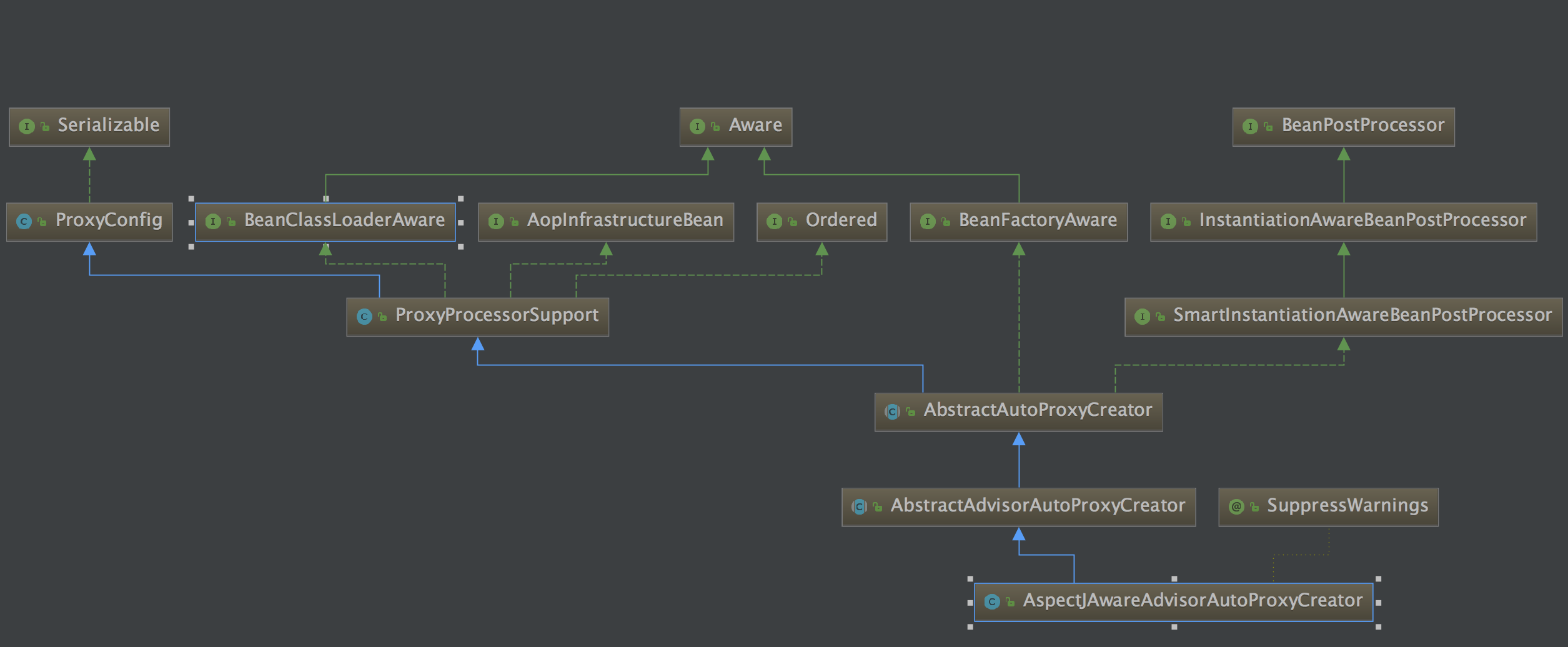Spring系列之-Spring AOP设计原理(二)
2017-12-24 00:00
459 查看
Spring系列之-Spring AOP设计原理(一)中讲述了Spring AOP初始化过程。Spring AOP是基于代理模式实现的,而为对象建立代理的这种过程是在Spring 调用getBaen()方法第一次获取Bean的过程。我们在上一文中分析到,在解析<aop:config>中Spring注册了一个AspectJAwareAdvisorAutoProxyCreator到容器中,这个类是Spring AOP代理建立过程中的核心类,其继承体系如下:

可以看到在AspectJAwareAdvisorAutoProxyCreator的继承体系过程中AspectJAwareAdvisorAutoProxyCreator间接实现了InstantiationAwareBeanPostProcessor接口,二InstantiationAwareBeanPostProcessor继承于BeanPostProcessor。
BeanPostProcessor这个接口再熟悉不过了,在Spring第一次调用getBean()方法时会对Bean进行实例化并依赖注入,只要实现BeanPostProcessor接口的类会在初始化Bean过程中调用BeanPostProcessor接口的方法。
真正实现BeanPostProcessor系列接口的是AspectJAwareAdvisorAutoProxyCreator的父类AbstractAutoProxyCreator,具体方法如下:
Object[] specificInterceptors = getAdvicesAndAdvisorsForBean(bean.getClass(), beanName, null);这句代码判断具体哪些bean需要创建代理。该方法是一个抽象方法其实现在AbstractAdvisorAutoProxyCreator中
这系列代码就是获取到当前bean所对应的通知,目前是判断当前Bean是否需要创建代理,暂时不详细研究知道这里。
回到上面如果当前bean需要创建代理则调用createProxy方法为当前bean创建代理并返回代理对象。
createProxy方法实现如下:
proxyFactory.isProxyTargetClass()这句代码判断是否是使用jdk代理还是使用cglib进行代理,<aop:config>中proxy-target-class这个属性值用于决定是否使用类的代理还是基于接口代理,缺省情况下proxy-target-class=false,如果为ture说明是基于类的代理需要cglib库,否则使用JDK动态代理,前提是有接口。
向代理工厂设置完相关参数后就会调用工厂方法中的 return proxyFactory.getProxy(getProxyClassLoader());创建代理对象。
代码非常简单创建AOP代理实现类并且调用getProxy方法获取代理对象。
DefaultAopProxyFactory实现了AopProxyFactory,createAopProxy实现方法如下:
这段代码主要决定使用何种代理方式
1.如果使用平台优化(config.isOptimize())或者 是直接代理类(config.isProxyTargetClass())或者没有实现任何接口进入if判断
2.如果代理类是接口或者被判断是一个动态代理类即proxy-target-class="false"或者没有设置proxy-target-class属性
满足上述1,2使用JDK动态代理,否则使用Cglib创建代理对象。
如果不满足1则直接使用JDK动态代理。
下面我们看JDK动态代理是如何创建代理对象
如果使用Jdk动态代理将会调用下面方法获取代理对象;
return Proxy.newProxyInstance(classLoader, proxiedInterfaces, this)
这句代理就能看见JDK动态代理的影子了。
熟悉JDK原生代理的人都知道,要使用JDK代理必须创建一个类实现InvocationHandler,这里JdkDynamicAopProxy本身就实现了InvocationHandler,故Proxy.newProxyInstance(classLoader, proxiedInterfaces, this)传入的是this。
JdkDynamicAopProxy必须要实现InvocationHandler中的invoke方法,我们看下invoke方法是如何实现:

可以看到在AspectJAwareAdvisorAutoProxyCreator的继承体系过程中AspectJAwareAdvisorAutoProxyCreator间接实现了InstantiationAwareBeanPostProcessor接口,二InstantiationAwareBeanPostProcessor继承于BeanPostProcessor。
BeanPostProcessor这个接口再熟悉不过了,在Spring第一次调用getBean()方法时会对Bean进行实例化并依赖注入,只要实现BeanPostProcessor接口的类会在初始化Bean过程中调用BeanPostProcessor接口的方法。
真正实现BeanPostProcessor系列接口的是AspectJAwareAdvisorAutoProxyCreator的父类AbstractAutoProxyCreator,具体方法如下:
public Object postProcessAfterInitialization(Object bean, String beanName) throws BeansException {
if (bean != null) {
Object cacheKey = getCacheKey(bean.getClass(), beanName);
if (!this.earlyProxyReferences.contains(cacheKey)) {
return wrapIfNecessary(bean, beanName, cacheKey);
}
}
return bean;
}
protected Object wrapIfNecessary(Object bean, String beanName, Object cacheKey) {
if (beanName != null && this.targetSourcedBeans.contains(beanName)) {
return bean;
}
if (Boolean.FALSE.equals(this.advisedBeans.get(cacheKey))) {
return bean;
}
if (isInfrastructureClass(bean.getClass()) || shouldSkip(bean.getClass(), beanName)) {
this.advisedBeans.put(cacheKey, Boolean.FALSE);
return bean;
}
// 如果当前bean存在通知,则创建代理
Object[] specificInterceptors = getAdvicesAndAdvisorsForBean(bean.getClass(), beanName, null);
if (specificInterceptors != DO_NOT_PROXY) {
this.advisedBeans.put(cacheKey, Boolean.TRUE);
Object proxy = createProxy(
bean.getClass(), beanName, specificInterceptors, new SingletonTargetSource(bean));
this.proxyTypes.put(cacheKey, proxy.getClass());
return proxy;
}
this.advisedBeans.put(cacheKey, Boolean.FALSE);
return bean;
}Object[] specificInterceptors = getAdvicesAndAdvisorsForBean(bean.getClass(), beanName, null);这句代码判断具体哪些bean需要创建代理。该方法是一个抽象方法其实现在AbstractAdvisorAutoProxyCreator中
@Override
protected Object[] getAdvicesAndAdvisorsForBean(Class<?> beanClass, String beanName, TargetSource targetSource) {
List<Advisor> advisors = findEligibleAdvisors(beanClass, beanName);
if (advisors.isEmpty()) {
return DO_NOT_PROXY;
}
return advisors.toArray();
}
protected List<Advisor> findEligibleAdvisors(Class<?> beanClass, String beanName) {
//获取所有定义的通知,直接从Spring BeanFactory中获取,这里会获取到befor和after所对应的通知bean
List<Advisor> candidateAdvisors = findCandidateAdvisors();
List<Advisor> eligibleAdvisors = findAdvisorsThatCanApply(candidateAdvisors, beanClass, beanName);
extendAdvisors(eligibleAdvisors);
if (!eligibleAdvisors.isEmpty()) {
eligibleAdvisors = sortAdvisors(eligibleAdvisors);
}
return eligibleAdvisors;
}
protected List<Advisor> findAdvisorsThatCanApply(
List<Advisor> candidateAdvisors, Class<?> beanClass, String beanName) {
ProxyCreationContext.setCurrentProxiedBeanName(beanName);
try {
return AopUtils.findAdvisorsThatCanApply(candidateAdvisors, beanClass);
}
finally {
ProxyCreationContext.setCurrentProxiedBeanName(null);
}
}这系列代码就是获取到当前bean所对应的通知,目前是判断当前Bean是否需要创建代理,暂时不详细研究知道这里。
回到上面如果当前bean需要创建代理则调用createProxy方法为当前bean创建代理并返回代理对象。
Object[] specificInterceptors = getAdvicesAndAdvisorsForBean(bean.getClass(), beanName, null);
if (specificInterceptors != DO_NOT_PROXY) {
this.advisedBeans.put(cacheKey, Boolean.TRUE);
Object proxy = createProxy(
bean.getClass(), beanName, specificInterceptors, new SingletonTargetSource(bean));
this.proxyTypes.put(cacheKey, proxy.getClass());
return proxy;
}createProxy方法实现如下:
protected Object createProxy(
Class<?> beanClass, String beanName, Object[] specificInterceptors, TargetSource targetSource) {
if (this.beanFactory instanceof ConfigurableListableBeanFactory) {
AutoProxyUtils.exposeTargetClass((ConfigurableListableBeanFactory) this.beanFactory, beanName, beanClass);
}
//实例化一个代理工厂
ProxyFactory proxyFactory = new ProxyFactory();
proxyFactory.copyFrom(this);
//判断是否直接代理当前类或使用接口代理,
if (!proxyFactory.isProxyTargetClass()) {
if (shouldProxyTargetClass(beanClass, beanName)) {
proxyFactory.setProxyTargetClass(true);
}
else {
evaluateProxyInterfaces(beanClass, proxyFactory);
}
}
Advisor[] advisors = buildAdvisors(beanName, specificInterceptors);
for (Advisor advisor : advisors) {
proxyFactory.addAdvisor(advisor);
}
proxyFactory.setTargetSource(targetSource);
customizeProxyFactory(proxyFactory);
proxyFactory.setFrozen(this.freezeProxy);
if (advisorsPreFiltered()) {
proxyFactory.setPreFiltered(true);
}
return proxyFactory.getProxy(getProxyClassLoader());
}proxyFactory.isProxyTargetClass()这句代码判断是否是使用jdk代理还是使用cglib进行代理,<aop:config>中proxy-target-class这个属性值用于决定是否使用类的代理还是基于接口代理,缺省情况下proxy-target-class=false,如果为ture说明是基于类的代理需要cglib库,否则使用JDK动态代理,前提是有接口。
向代理工厂设置完相关参数后就会调用工厂方法中的 return proxyFactory.getProxy(getProxyClassLoader());创建代理对象。
public Object getProxy(ClassLoader classLoader) {
return createAopProxy().getProxy(classLoader);
}代码非常简单创建AOP代理实现类并且调用getProxy方法获取代理对象。
DefaultAopProxyFactory实现了AopProxyFactory,createAopProxy实现方法如下:
public AopProxy createAopProxy(AdvisedSupport config) throws AopConfigException {
if (config.isOptimize() || config.isProxyTargetClass() || hasNoUserSuppliedProxyInterfaces(config)) {
Class<?> targetClass = config.getTargetClass();
if (targetClass == null) {
throw new AopConfigException("TargetSource cannot determine target class: " +
"Either an interface or a target is required for proxy creation.");
}
if (targetClass.isInterface() || Proxy.isProxyClass(targetClass)) {
return new JdkDynamicAopProxy(config);
}
return new ObjenesisCglibAopProxy(config);
}
else {
return new JdkDynamicAopProxy(config);
}
}这段代码主要决定使用何种代理方式
1.如果使用平台优化(config.isOptimize())或者 是直接代理类(config.isProxyTargetClass())或者没有实现任何接口进入if判断
2.如果代理类是接口或者被判断是一个动态代理类即proxy-target-class="false"或者没有设置proxy-target-class属性
满足上述1,2使用JDK动态代理,否则使用Cglib创建代理对象。
如果不满足1则直接使用JDK动态代理。
下面我们看JDK动态代理是如何创建代理对象
如果使用Jdk动态代理将会调用下面方法获取代理对象;
public Object getProxy(ClassLoader classLoader) {
if (logger.isDebugEnabled()) {
logger.debug("Creating JDK dynamic proxy: target source is " + this.advised.getTargetSource());
}
Class<?>[] proxiedInterfaces = AopProxyUtils.completeProxiedInterfaces(this.advised, true);
findDefinedEqualsAndHashCodeMethods(proxiedInterfaces);
return Proxy.newProxyInstance(classLoader, proxiedInterfaces, this);
}return Proxy.newProxyInstance(classLoader, proxiedInterfaces, this)
这句代理就能看见JDK动态代理的影子了。
熟悉JDK原生代理的人都知道,要使用JDK代理必须创建一个类实现InvocationHandler,这里JdkDynamicAopProxy本身就实现了InvocationHandler,故Proxy.newProxyInstance(classLoader, proxiedInterfaces, this)传入的是this。
JdkDynamicAopProxy必须要实现InvocationHandler中的invoke方法,我们看下invoke方法是如何实现:
public Object invoke(Object proxy, Method method, Object[] args) throws Throwable {
MethodInvocation invocation;
Object oldProxy = null;
boolean setProxyContext = false;
TargetSource targetSource = this.advised.targetSource;
Class<?> targetClass = null;
Object target = null;
try {
if (!this.equalsDefined && AopUtils.isEqualsMethod(method)) {
// The target does not implement the equals(Object) method itself.
return equals(args[0]);
}
else if (!this.hashCodeDefined && AopUtils.isHashCodeMethod(method)) {
// The target does not implement the hashCode() method itself.
return hashCode();
}
else if (method.getDeclaringClass() == DecoratingProxy.class) {
// There is only getDecoratedClass() declared -> dispatch to proxy config.
return AopProxyUtils.ultimateTargetClass(this.advised);
}
else if (!this.advised.opaque && method.getDeclaringClass().isInterface() &&
method.getDeclaringClass().isAssignableFrom(Advised.class)) {
// Service invocations on ProxyConfig with the proxy config...
return AopUtils.invokeJoinpointUsingReflection(this.advised, method, args);
}
Object retVal;
if (this.advised.exposeProxy) {
// Make invocation available if necessary.
oldProxy = AopContext.setCurrentProxy(proxy);
setProxyContext = true;
}
// May be null. Get as late as possible to minimize the time we "own" the target,
// in case it comes from a pool.
target = targetSource.getTarget();
if (target != null) {
targetClass = target.getClass();
}
// Get the interception chain for this method.
List<Object> chain = this.advised.getInterceptorsAndDynamicInterceptionAdvice(method, targetClass);
// Check whether we have any advice. If we don't, we can fallback on direct
// reflective invocation of the target, and avoid creating a MethodInvocation.
if (chain.isEmpty()) {
// We can skip creating a MethodInvocation: just invoke the target directly
// Note that the final invoker must be an InvokerInterceptor so we know it does
// nothing but a reflective operation on the target, and no hot swapping or fancy proxying.
Object[] argsToUse = AopProxyUtils.adaptArgumentsIfNecessary(method, args);
retVal = AopUtils.invokeJoinpointUsingReflection(target, method, argsToUse);
}
else {
// We need to create a method invocation...
invocation = new ReflectiveMethodInvocation(proxy, target, method, args, targetClass, chain);
// Proceed to the joinpoint through the interceptor chain.
retVal = invocation.proceed();
}
// Massage return value if necessary.
Class<?> returnType = method.getReturnType();
if (retVal != null && retVal == target &&
returnType != Object.class && returnType.isInstance(proxy) &&
!RawTargetAccess.class.isAssignableFrom(method.getDeclaringClass())) {
// Special case: it returned "this" and the return type of the method
// is type-compatible. Note that we can't help if the target sets
// a reference to itself in another returned object.
retVal = proxy;
}
else if (retVal == null && returnType != Void.TYPE && returnType.isPrimitive()) {
throw new AopInvocationException(
"Null return value from advice does not match primitive return type for: " + method);
}
return retVal;
}
finally {
if (target != null && !targetSource.isStatic()) {
// Must have come from TargetSource.
targetSource.releaseTarget(target);
}
if (setProxyContext) {
// Restore old proxy.
AopContext.setCurrentProxy(oldProxy);
}
}
}
相关文章推荐
- Spring系列之-Spring AOP设计原理(一)
- spring系列(三)——springAOP原理探究(CGLIB代理机制)
- 深入解析Spring架构与设计原理(二)AOP原理
- Spring技术内幕——深入解析Spring架构与设计原理(二)AOP
- Spring 系列:AOP原理
- 死磕Spring AOP系列5:设计模式在AOP中的使用
- 深入解析Spring架构与设计原理-AOP
- Spring技术内幕——深入解析Spring架构与设计原理(二)AOP
- Spring系列之 (八):AOP实现原理
- Spring技术内幕——深入解析Spring架构与设计原理(二)AOP
- Spring技术内幕——深入解析Spring架构与设计原理(二)AOP
- AOP的概念和实现原理—Spring系列介绍
- Spring基于注解形式的 AOP的原理流程及源码解析(四)
- 反射实现AOP动态代理模式(SpringAOP的实现原理)
- Spring系列之AOP
- 《Spring技术内幕——深入解析Spring架构与设计原理》连载1
- 深入解析Spring架构与设计原理3
- spring5——Aop的实现原理(动态代理)
- 《Spring技术内幕——深入解析Spring架构与设计原理》连载2
- Spring AOP 实现原理
